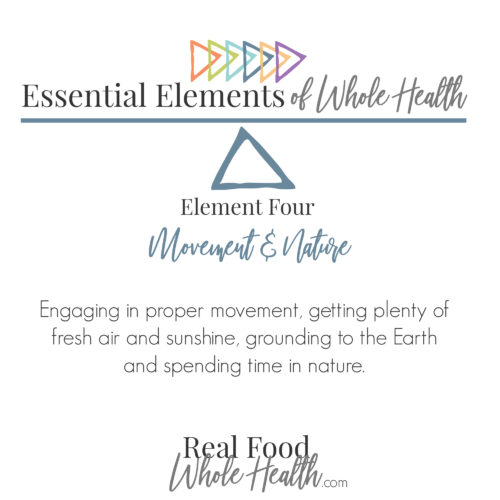
This article is the fifth in a series of posts exploring the Essential Six Elements of Whole Health, the core of our health philosophy and the foundation for our work with our nutritional therapy clients.
This article will be in two parts, this is part one. Learn more about the Essential Elements and find the rest of the series here.
So far in our Essential Elements series, we’ve covered A Real Food Diet, The Physical Body (parts one, two and three) and Non-Toxic Lifestyle (parts one, two and three).
While the foods we choose to eat, the health status of our physical body and the importance of choosing non-toxic products are extremely important factors to our health, we can not neglect Essential Element Four: Movement & Nature.
The Movement & Nature Element includes engaging in proper movement, getting plenty of fresh air and sunshine, grounding to the Earth and spending time in nature.
So, let’s take this a piece at a time.
First, is engaging in proper movement.
What do we mean when we talk about “proper” movement? Proper movement is that which fully satisfies your body’s needs, without overtraining, causing stress in the body or inflicting injury.
Proper movement is respectful of the body and in balance with the rest of the Elements of Whole Health.
Your current health status is a huge determining factor in how much movement your body actually needs, and it’s listening to your body, and not a blanket recommendation from an authority, that is most important.
It is vital to get SOME movement, even if it’s just a walk around the block, but just as vital not to force yourself to be too active, simply because you think that it is “healthy” to exercise.
There is really no ONE correct way for people to move. Individual needs will vary according to your health status and health goals. There are a few guidelines, however, that we can follow.
It’s important to make activity a part of our daily life, rather than suffering through hours at the gym.
It’s best for our bodies when our movement has PURPOSE.
This would be walking to the store or farmers market, the activity involved in gardening or lawn care, and moving for fun as in playing outdoor games.
Movement doesn’t have to be strenuous to be beneficial. Stretching, yoga and exercises like Tai Chi are all ancient practices and help both the body and the mind.
Flexibility is a very important quality, and these gentle movements help maintain and increase our normally decreasing flexibility as we age.
We would be wise to mimic the way that animals move, which is very similar to how humans used to move in pre-industrial times.
You don’t see animals running for 26 miles (like in a marathon), do you? They aren’t spending hours doing chronic cardio, which breaks down the body and sets the stage for illness, either.
No, most animals move frequently at a slow pace with occasional bursts of intense activity, usually either to catch dinner or avoid becoming dinner. They rest frequently in between bouts of activity.
Some popular regimens like Interval Training or High Intensity Interval Training (HIIT), Peak 8, P.A.C.E and many of the fitness programs endorsed by the Primal/Paleo community follow this model and also include strength training and adequate periods of rest.
More often than not, movement is best done outside, in the fresh air, where you can take advantage of the added benefits of sunshine, being surrounded by Nature and grounding with the Earth.
We’ll explain these further and cover their benefits in the next part of this article.


Comments are closed.